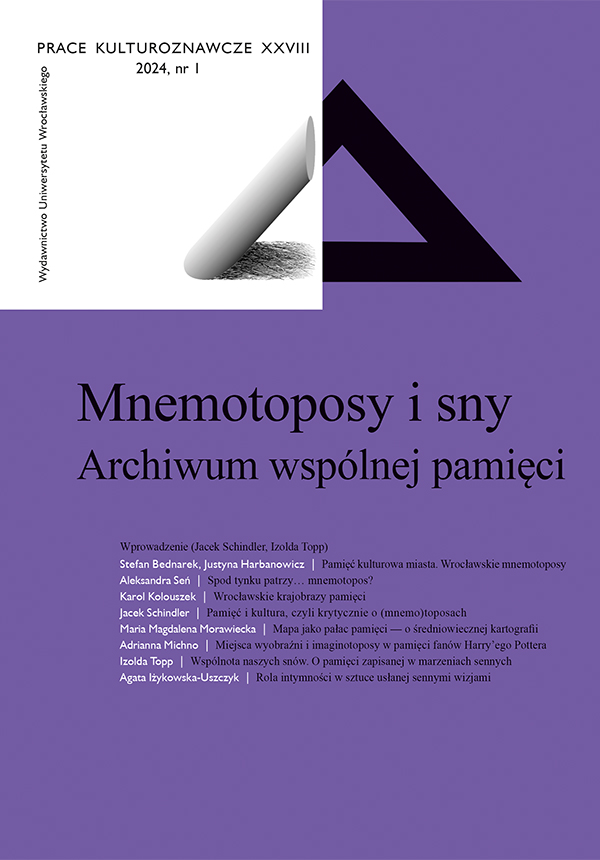

Articles

The article presents a proposal for implementing the concept of mnemotopos developed in cultural studies into the analysis of historical cartographic representations. The author’s aim is to show the cognitive potential resulting from applying the metaphor of “places of memory” to images representing geographical locations, which acquires particular significance in the case of the historical period in question (the Middle Ages), with its rich tradition of didactic applications of visual materials and their relation to the ars memoriae. First, the topic is set in the context of the cultural studies tradition. This is followed by a brief discussion of the typology of medieval maps and then an outline of a theory that argues in favour of the existence of a correlation between the form of the most popular medieval cartographic type and the so-called rotae (“wheels of memory”), which were used contemporaneously in monastic culture. The article goes on to list arguments for recognising a possible link between maps and studies on cultural forms of memory and memorising, supported by examples from source materials. Finally, the author refers to the titular metaphor of a “palace of memory.” The objective is to demonstrate how the medieval approach to cartographic locations can be linked to the mnemonic method of loci discussed in the article, which would provide a rationale for seeing them as classic mnemotopoi.
Bednarek S., Mnemotoposy. Słowo wstępne, „Przegląd Kulturoznawczy” 2012, nr 1.
Campbell T., Portolan charts from the late thirteenth century to 1500, [w:] The History of Cartography, red. J.B. Harley, D. Woodward, t. 1, Chicago 1987.
Edson E., Mapping Time and Space: How Medieval Mapmakers Viewed Their World, London 1998.
Edson E., The Word Map 1300–1492: The Persistence of Tradition and Transformation, Baltimore 2007.
Harley J.B., Silences and secrecy: The hidden agenda of cartography in early modern Europe, [w:] J.B. Harley, The New Nature of Maps: Essays in the History of Cartography, Baltimore-London 2001.
Harvey P.D.A., The Hereford World Map, London 1996.
Kitzinger E., World map and fortune’s wheel: A medieval mosaic floor in Turin, „American Philosophical Society” 117, 1973, nr 5.
Kline N.R., Maps of Medieval Thought: The Hereford Paradigm, Woodbridge 2001.
Metafory pamięci, red. G. Marzec, Łódź 2017.
Morawiecka M.M., In a circle — the Hereford Map as a “cosmic clock”, „Imago Mundi: International Journal for the History of Cartography” 75, 2023, nr 1.
Rodini E., Memory and maps, [hasło w:] Trade, Travel, and Exploration in the Middle Ages: An Encyclopedia, red. J.B. Friedman, K.M. Figg, New York-London 2000.
Westrem S.D., The Hereford Map: A Transcription and Translation of the Legends with Commentary, Turnhout 2001.
Woodward D., Medieval mappaemundi, [w:] The History of Cartography, red. J.B. Harley, D. Woodward, t. 1, Chicago 1987.
Zalewska-Lorkiewicz K., Ilustrowane mappae mundi jako obraz świata. Średniowiecze i początek okresu nowożytnego, Warszawa 1997.
Dora V. della, Mapping metageographies: The cartographic invention of Italy and the Mediterranean, „California Italian Studies Journal” 1, 2010, nr 1, https://escholarship.org/uc/item/6g23b4fs.
Hamburger J.F., Maps of the Mind: Diagrams Medieval and Modern, wykład wygłoszony 24 października 2022 roku w British Library w Londynie w ramach serii „The Panizzi Lectures”, https://www.youtube.com/watch?v=mQwa1jnSTmQ.
Marchese F.T., The Origins and Rise of Medieval Information Visualization, materiały konferencyjne z „16th International Conference on Information Visualisation” 2012, http://csis.pace.edu/~marchese/Papers/IV12/Marchese_IV’12_Pub.pdf.
Niedźwiedź J., Polonia noviter reperta. Mapy: definiowanie siebie i świata w XVI wieku „Autoportret” 2014, nr 1 (44), https://www.autoportret.pl/artykuly/polonia-noviter-reperta-mapy-definiowanie-siebie-i-swiata-w-xvi-wieku/.